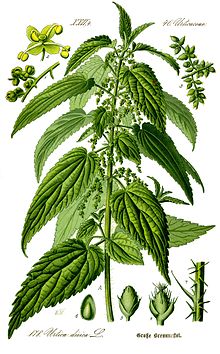Herbal manure
Plant manure is mainly used by hobby gardeners as a natural, mild plant protection agent in biological plant protection. Liquid manure from nettles , comfrey , field horsetail , garlic or onions are used as fertilizers with a possibly strengthening effect and as a preventive measure or in the event of fungal infections (as a fungicide ). Plant manure is high in nitrogen and potassium. This makes them particularly suitable for heavily draining plants such as tomatoes .
Manufacturing
Put 1 kg of fresh, roughly cut herbs in 10 liters of water, preferably in barrels made of wood, earthenware or polyethylene . You can also buy dried herbs or dry mixes, 150–200 g / 10 liters of water are sufficient.
The barrel is placed in a sunny, warm place and covered with a grate. Now the liquid manure has to ferment for one to two weeks so that the active plant ingredients such. B. silica are released.
The unavoidable odor nuisance can be kept within limits by adding rock flour during daily stirring. The liquid manure is ready when it no longer foams and has turned a dark color.
Decomposition of biomass in water
The production of plant manure is basically a decomposition of dead biomass in water. The bound nitrogen is converted to ammonia (NH 3 ) by destructors . Under aerobic conditions, aerobic bacteria oxidize the released ammonia during nitrification to nitrite (NO 2 - ) and further to nitrate (NO 3 - ).
In water, ammonia reacts with water to form ammonium ions (NH 4 + ), which creates OH ions and therefore increases the pH value:
Most of the nitrogen in nettle manure is in the form of ammonium ions, with a total nitrogen concentration of 30–40 mM (corresponds to approx. 0.04–0.06% nitrogen content in the undiluted manure). The high pH value of the liquid manure also leads to a more efficient absorption of ammonium ions than from a normal nutrient solution, which also promotes growth. If there are anaerobic conditions (e.g. due to the consumption of oxygen by aerobic and facultative anaerobic microorganisms), certain anaerobic bacteria can reduce nitrate via nitrite to ammonium. This process is known as nitrate ammonification . Other bacteria convert nitrate to nitrogen (N 2 ) during denitrification by using it as an oxidant for their oxidative energy metabolism . The resulting N 2 is released and is released into the atmosphere.
application
The liquid manure is sieved and diluted 1:10 with water in order to achieve an optimal fertilizing effect. Alternatively, the plants can be sprayed on the top and bottom of the leaves as a preventive measure against pests. As a natural and inexpensive fertilizer, plant manure is suitable, for example, for vegetable plants during the growing season. However, when attaching the liquid manure, care should be taken that it can easily burn the leaves and stems. Therefore, the liquid manure is preferably applied directly to the root area of the plants on cloudy days or at dusk, preferably on already moist soil.
The ingredients for preparing some manure or corresponding plant extracts are listed as plant strengtheners by the Federal Office for Consumer Protection and Food Safety and are offered in stores by various companies. The various tonics are said to have different effects: manure from field horsetail is said to help against powdery mildew and other fungal diseases of plants as well as against lice and spider mites. Liquid manure from nettles is also used against aphids, spider mites and fungal diseases and is also considered a natural fertilizer.
Web links
- More information at "Staudengärten.de" ( Memento from December 24, 2013 in the Internet Archive )
- Herbal broths, manures, teas
- Preparation and use of nettle manure
Individual evidence
- ↑ Peterson & Jensén (1985) Effects of Nettle Water on Growth and Mineral Nutrition of Plants. I. Composition and Properties of Nettle Water. Biological Agriculture & Horticulture: An International Journal for Sustainable Production Systems, 2, 303-314. doi : 10.1080 / 01448765.1985.9754444 .
- ↑ Peterson & Jensén (1988) Uptake and transport of N, P and K in tomato supplied with nettle water and nutrient solution. Plant and Soil, 107, 189-196. doi : 10.1007 / BF02370546 .
- ↑ Robert Guderian: Aquati Systems, Volume 1 Springer Verlag 2000, ISBN 978-3-540-66187-0 , pp. 19ff.
- ↑ Peterson & Jensén (1986): Effects of Nettle Water on Growth and Mineral Nutrition of Plants. II. Pot and Water Culture Experiments. Biological Agriculture & Horticulture: An International Journal for Sustainable Production Systems, 4, 7-18. doi : 10.1080 / 01448765.1986.9754482 .

